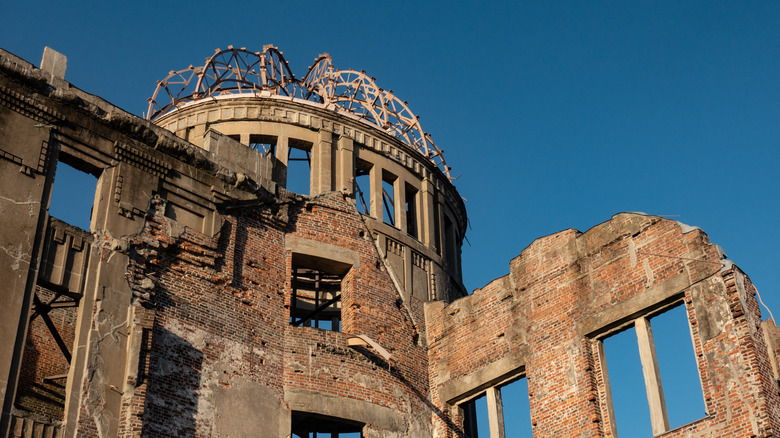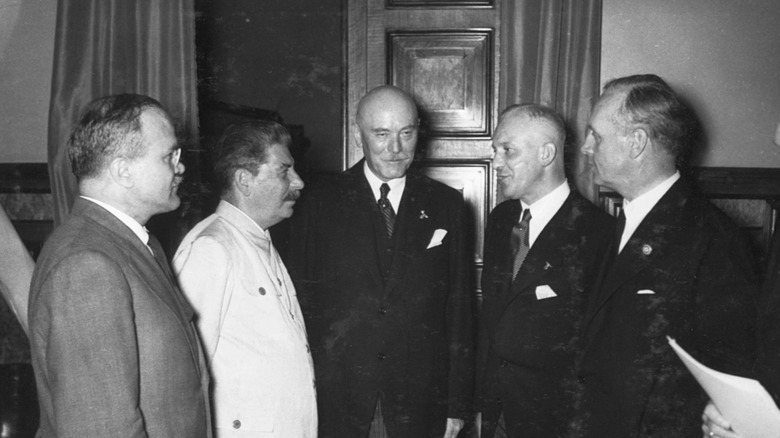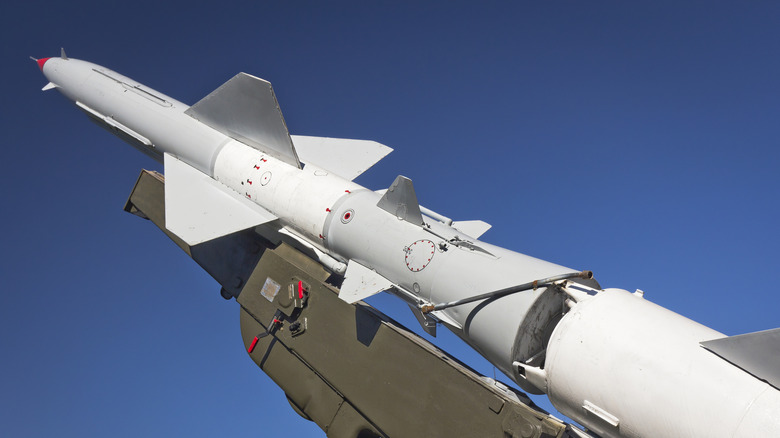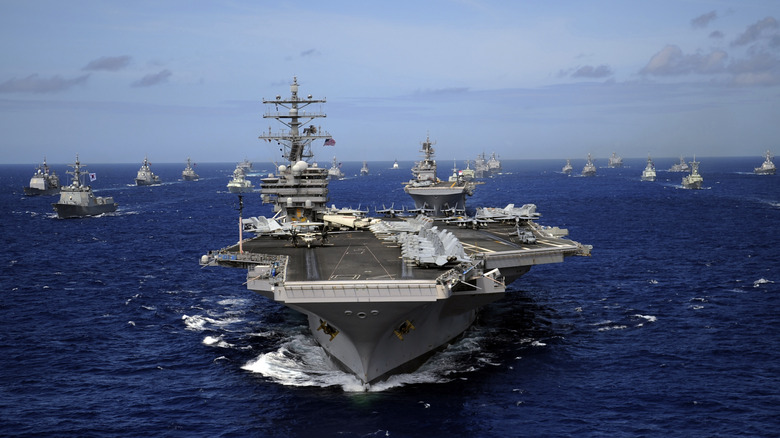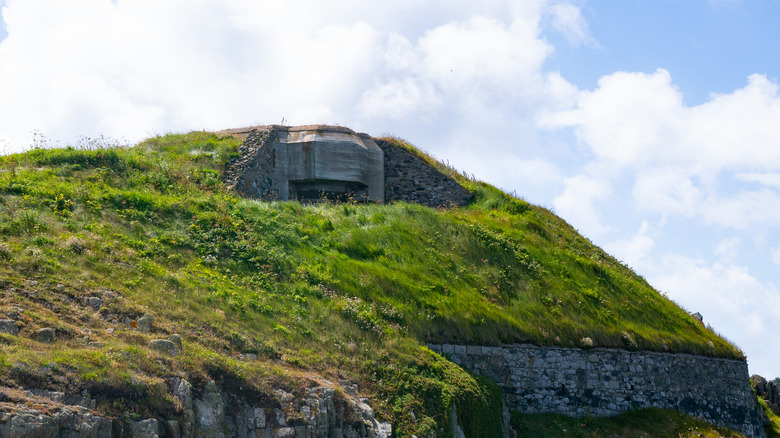Is This What The World Would Look Like If Hitler Had Developed The Atomic Bomb First?
Of all the dreadful weapons developed and used during World War II, none are more terrifying than the atomic bomb. Used only twice in conflict — both times by the U.S. against Japan in August 1945 — the mere threat of nuclear war has since influenced global events and shaped the present world. The U.S. poured massive amounts of resources into building and deploying the atomic bomb before anyone else, but one lingering question still remains: What if Hitler had gotten his hands on an atomic bomb first?
After German and Austrian scientists discovered nuclear fission in December 1938, Germany had a head start in the atomic race, and military applications were swiftly explored. By October 1940, the U.S. and Germany were in a dead heat to develop the bomb, but by 1942 Germany had all but given up, and U.S. efforts were about to get a serious boost with the Manhattan Project. It is possible, but by no means certain, that with different choices and a generous helping of luck, the Nazis could have been successful with their own messed-up nuclear weapons program.
However, World War II was no simple conflict. Peace treaties and pacts were made and broken, alliances shifted depending on success and defeat, and once-great powers found themselves greatly diminished while formerly quiescent nations rose. Exploring the consequences of the Nazis becoming the world's first nuclear power ventures into speculation, but some ramifications are likelier than others. From atomic bomb memorials in European cities to a U.S.-dominated Asia and a much different Cold War, this is what the world may have looked like if Hitler had beaten the U.S. to the atomic punch.
The first and last atomic bomb was used in Europe instead of Japan
The wholesale destruction of cities was considered fair game during World War II. From Dresden to London, European cities were mercilessly bombed, and so it would be reasonable to expect Nazi Germany to use an atomic bomb like most of their bombs were during the war: on European cities.
But Germany would have needed to test an atomic bomb first. Unlike parts of the U.S. and Russia, Europe is a crowded, densely populated region, and an atomic test by Germany would have been impossible to conceal. Transporting a nuclear bomb to a remote, non-European destination would have been risky, and Germany did not have a bomber large enough to reliably fly one a great distance. Add to this the then-poorly understood nature of radioactive fallout, and a logical conclusion might be that the very first use of a Nazi atomic bomb would have been on a city on the European mainland. And that could have spared Japan from the same fate.
The casualty reports flowing from Hiroshima and Nagasaki soon began to indicate that nuclear weapons were unimaginably worse than previously thought. Horrific burns, even more horrific symptoms of radiation sickness, and the lingering effects of radioactive fallout that could affect future generations all gave the emerging nuclear powers pause. Hiroshima and Nagasaki are once again thriving cities, but had Hitler used the atomic bomb first, the memorials to those who lost their lives where the first atomic bombs fell may have instead sat in the center of European cities, grave warnings of the cost of nuclear war.
Soviet Russia and Germany returned to an uneasy truce
At the end of World War II, the Allies included Soviet Russia, which had swept across Eastern Europe and into Eastern Germany. But at the very start of World War II, Stalin's Russia and Hitler's Germany were bound by a non-aggression pact, and the opening salvos of that conflict began in 1939 with both powers invading Poland. Some two years later, in June 1941, Hitler reneged on the peace treaty between Germany and Russia and invaded the latter. Historians have speculated that Stalin would have done the same and that it was a matter of time, but opening the eastern front would eventually cripple Germany and turn the tide against it. Had Hitler stymied Stalin with an atomic bomb, could he have gone on to defeat him and win the Eastern Front?
After the U.S. demonstrated its newfound nuclear capabilities, Soviet Russia threw resources into developing an atomic bomb, and the same would have likely been true if Germany had taken the U.S.'s place. Considering the losses that Russia suffered, the lack of concern for human life shown by Stalin, and the sheer vastness of Russia, the fighting would likely have continued, but with Germany in a stronger position. After all, far more lives were lost in the defense of Stalingrad than in Hiroshima and Nagasaki combined. The end result may have been another peace treaty, with Germany and Russia settling into a wary truce.
However, Soviet Russia would likely have lost the significant amount of European territory they captured during the last years of World War II, and so the divide between Western and Eastern Europe would look much different than today.
The Cold War included Nazi Germany as well as the U.S. and Soviet Russia
A few nations had emerging atomic weapons programs during the years following World War II, but only the U.S. and the Soviet Russia had both the technological and industrial capacity to produce them in significant quantities. As World War II made way for the Cold War, the two superpowers grew their nuclear arsenals to ludicrous levels in flagrant ignorance of the grave danger to humanity. Had Nazi Germany gotten the bomb and used it to seize permanent control of Europe's industrial capacity, they may have been the third major player in the Cold War.
Other nations since independently developed atomic weapons, but two of those — Britain and France — would likely have not done so with a Nazi-dominated Europe. Furthermore, NATO as we recognize it today would not exist, unless we consider the unlikely event Nazi Germany allied itself with the U.S. against Soviet Russia.
The Cold War, with its numerous proxy wars and veil of secrecy, was complicated enough with two superpowers jostling for supremacy. Adding Nazi Germany would have created a political three-body problem as unpredictable as it is in physics. But given the contempt for human life that the Nazis demonstrated, it would have made it an even more anxious period to live through.
The U.S. dominates Asia and the Pacific
After the Axis powers were defeated, the two dominant powers in Europe were the U.S. and the Soviet Russia, both of whom led the occupying forces in an economically devastated Europe. In 1948, the U.S. enacted the Marshall Plan, a massive program of economic assistance to Western Europe intended to rebuild its infrastructure and industry, with the intended benefit of keeping it aligned and allied with the U.S. Billions of dollars were poured into Europe, and those European beneficiary nations later formed an alliance that would arguably do the most to deter Soviet ambitions: NATO. But had Hitler used an atomic bomb to subjugate Europe and thwart U.S. influence there, to where would the U.S. have redirected their efforts to protect their interests abroad? Probably Asia, that's where.
After the Japanese attack on the U.S. military base at Pearl Harbor in December 1941, Japanese forces swept through Asia in the Pacific. But a mere six months later, the Japanese navy was dealt a crippling blow by the U.S. during the Battle of Midway. A long, grueling meatgrinder of a Pacific campaign followed, but despite their commitments in Europe, by mid-1945, the U.S.-led forces had Japan on its knees and seriously considering surrender. And then the U.S. dropped an atomic bomb on two Japanese cities, just to emphasize their situation.
Assuming Hitler gained an atomic bomb after the U.S. entered the war in 1941, but before they had committed many troops to Europe — and without the defeated colonial powers wanting their Pacific territories back — it's possible the U.S. would have become the pre-eminent power in Asia.
Britain becomes much like Taiwan
It's a long shot to predict how world events would have transpired had Hitler won the race to the atom bomb and subsequently the war in Europe, if indeed the latter were certain. However, we do know a couple of things about Hitler's attitude towards the island nation of Great Britain. And that, some eight decades later, could have resulted in a Britain that looks much like Taiwan does today — a thriving nation, but dependent on U.S. support for its continued survival, facing a hostile power across a narrow strait of water.
Firstly, while Hitler did explore the possibility of invading the British mainland, it was abandoned in favor of aerial bombardment and a form of containment. Secondly, Hitler had on several occasions encouraged Britain to consider a peace deal. Whether or not such a peace deal would have held firm after Hitler threatened Britain with nuclear attack is impossible to say, but the timing of such a hypothetical deal would be crucial. After all, following the December 1941 entry of the U.S. into World War II, American troops started flowing into Britain from January 1942. And the U.S. was also developing an atomic bomb.
The British had no intention to surrender, but even if Nazi Germany had used nuclear might to force a humiliating peace deal from Great Britain, the continued presence of U.S. troops may yet have saved the nation from complete domination. With the development of an American atomic bomb a certainty no matter what happened in Europe, a U.S.-supported Britain, with Nazi Europe across the English channel, may have ended up being the only remaining redoubt of Western democracy in Europe.

